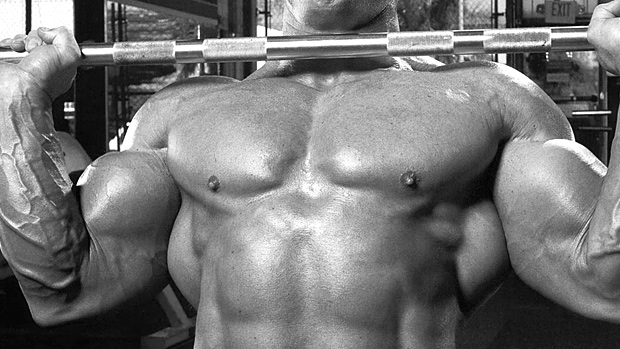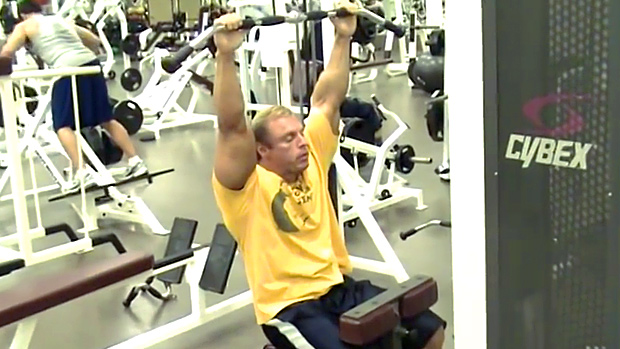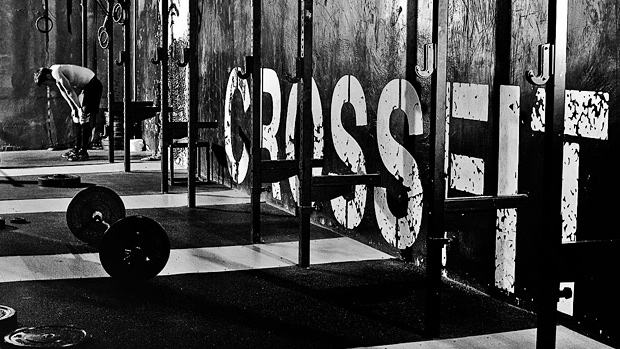The Strict Military Press
There was a time when the military press was revered, and the "average" American man was pretty remarkable. He was both feared and admired – strong yet compassionate, fiercely determined yet respectful, and above all else, never one to just take the easy way out.
Today every gym rat has an excuse for not busting his or her ass. You all know the type – this hurts, that's impinged, and jeepers creepers I can't do that lift, that's crazy! It's amazing any of them can tie their shoes without hyperextending their digitus medius.
Sure, there are individuals with debilitating injuries and those who orthopedically can't perform certain lifts, but for the vast majority this simply isn't the case. Most of these trainees, quite frankly, just hate working hard. They flat-out suck.
One of the most outlawed exercises today is the classic overhead press, or as some call it, the strict military press. This used to be the test of upper body strength before we started to lie down on benches.
As my colleagues Jim Wendler and Mark Rippetoe say, there's something innately manly about taking things from the ground and lifting them overhead. If you can lift a weight overhead, well, you pretty much just dominated it!
Alas, here comes Mr. Rehab, hot off a two-hour foam roll session:
- I have bad shoulders
- I have a bad neck
- I have bad back
- Or my personal favorite:
- I can't do military press, but I can do bench press...
Gimme a break.
While not everyone has the requisite mobility to military press right out of the gate (many men today have sissy jobs, sitting at a computer all day with poor posture which just magnifies the problem), the main reason the lift has become taboo is that it's difficult. You need to be extremely rigid from head to toe to have a strong standing press, not to mention have great mobility and stability in the shoulders and upper back.
But to those that persevere come the spoils. The military press will build cannonball-like shoulders, increase triceps and upper back strength, and build a rock solid core.
To that end, here are my top tips for a perfect military press. Follow these tips and you'll be light years ahead of your ignorant brethren in no time!
Keeping your shoulders down and back will improve your stability in all pressing patterns as scapula position is key in upper body training. You never want to shrug up or let the shoulders come forward when pressing.
Get-ups have been a staple in the kettlebell community for improving shoulder stability. You don't necessarily need to do these as a heavy lift, but even doing these naked or with a light weight as a warm-up will do wonders for improving stability overhead.
Check out this baby get-up variation. This is a great warm up for learning how to pack your shoulders.
Not into the whole get-up craze? Overhead carries are another way to develop overhead stability. You can also try doing these bottom-ups for an even greater challenge. Bottom-ups overhead walks and holds are great for training your body for the full body tension necessary for a heavy press.
If you don't have a kettlebell, a dumbbell will do just fine. I like using the bottom-up kettlebell to really get the irradiation effect from the grip to teach full body tension.
When performing any vertical pulling exercise, it's important to have the same packed shoulder position as you would in a press. Most people start to shrug up excessively when performing exercises like pull-ups and pull downs. For this reason, no matter what the level of the athlete, I always include some flexed-arm hang work in their programs to train the proper pull-up lockout position.
The shoulders should be pulled down and packed. The strength you'll gain in the upper back from this exercise will greatly improve shoulder stability, which will transfer over to a big press. Another great option is the kneeling X-Pulldown popularized by coach Mike Boyle. (See video below.)
This is a great shoulder friendly alternative to pull-up variations. Cables or bands work well with this.
Core strength is of paramount importance if you want to military press big. Since the lift is performed standing you need to actively control your legs and your spine. Most novice trainees with a weak core will try to turn the press into a standing incline press by hyper-extending their low back.
For that reason I like to start people off from a tall kneeling position to teach proper spinal alignment. This position makes it extremely difficult to lean back, especially with any appreciable amount of weight. Focus on getting tall and tight and squeezing the glutes while bracing the abs.
You need both core strength and stability to military press effectively. One of my favorite exercises to work both simultaneously is the Superman plank. It requires a ton of core strength and overhead stability – the further you move out, the harder the stability requirement. Be sure to keep the lats, abs, and glutes engaged to ensure proper shoulder and spinal alignment.
Only go out as far as you comfortably can – as you get stronger and more stable you can come out further.
When setting up for the military press you should imagine performing a standing leg press by trying to drive your heels through the ground. This will not only keep your presses strict, it will improve your overall stability and create tension throughout your lower body. The more tension you create in your legs, the more pressing potential.
Clench your glutes, pull your kneecaps up (flex your quads), and drive your heels through the floor. Your legs aren't going anywhere, but you'll feel an immense tension throughout your body.
A great way to start integrating lower body stability training is by pressing from a half-kneeling position. This will help develop hip and pelvic stability while doing military press. Get tall and tight and drive your front heel and back toe into the floor to root yourself into the ground and help create lower body tension.
I know what you're thinking: "Man I haven't even seen a barbell yet!" Military pressing requires a lot of prep work and real men don't skip steps!
One of the most popular cues when doing militry press is to "get your head through." While this may work for some, it can be problematic for others. You never want to sacrifice neck position and stretch the head out too far.
I like to think about getting my entire body under the load as the bar passes my eyes. The closer the barbell is to your center of gravity the stronger you'll be.
Don't press the weight too far forward – you want to keep the bar path as close to a straight line as possible. This means you can actually manipulate your body around the weight.
It's okay to lean back a bit to get the press going and to lean forward a touch as you lock the weight out. Always make sure the barbell lines up with your ears, shoulders, hips, knees, and ankles during the lockout.
My favorite drill is an old favorite I first introduced during my T Nation debut, the Z-Press.
The Z-Press really builds up your core musculature and teaches the proper lockout for the press. Set your butt down in a power rack with your legs straight out in front of you and press overhead. You must lean forward and embrace the proper lockout position – you won't be able to do any appreciable weight if you lean back. This lights up your core and upper back like never before.
You can play with different pin heights and reps range, but this is typically done as an assistance lift for 5 or more reps.
Feel free to try the single-arm military press as well, one of fellow T Nation contributor Todd Bumgardner's favorites! You can use kettlebells or dumbbells for this exercise.
The focus during any overhead press should be getting your body "through" to ingrain the proper lockout. This requires considerable shoulder flexion and external rotation.
All forms of wall slides and floor slides are great for developing the necessary mobility for a proper press and help warm up the muscles in the shoulders and upper back.
Below is one of my favorite warm-ups to do before the overhead press:
This teaches you the proper overhead position while activating the muscles necessary to stabilize the shoulders for a strong standing press.
It's also important to hit soft tissue work before your overhead sessions and to add in movement at the shoulders to improve tissue quality and mobility.
Grab a lacrosse ball and go to town leaning against a power rack. Be sure to hit the muscles around the chest and upper back before your pressing workout.
Here's a sample soft tissue routine for overhead lifting. Remember to hit the same movement patterns with the lacrosse ball on upper back as well.
It's extremely important at the start of the military press to focus on getting the elbows directly under the bar at the lockout. You don't want to press the weight forward at either end position. Achieving this position requires significant strength and mobility in the shoulders and upper back.
One of the best drills to improve shoulder external rotation while at the same time building strength in the rotator cuff is the tall kneeling band press with RNT (reactive neuromuscular training).
I first learned this drill from my friend Joe Bonyai who's a real bright strength coach in New York. It's another form of RNT – the band is pulling the lifter forward, forcing him to reactively turn on the muscles in the rotator cuff and upper back to stabilize the shoulders and effectively press overhead.
This can also be used as a warm-up with lighter bands or as a patterning drill to teach proper overhead press technique.
A similar drill that I learned from James Smith is the hip-hinge scarecrow. Assume a hip-hinge position and then externally rotate and press. This is an awesome shoulder warm-up.
Experiment with different variations of this powerful exercise – you can perform it holding lacrosse balls to further increase the tension, holding a mini-band stretched out to increase the tension in your upper back, or even lying prone on an incline bench.
If you want to train like you have a pair of functioning testes, you need to start military pressing. Here's a quick pressing review:
- Pack your shoulders. Keep your shoulders down and back to ensure proper shoulder stability.
- Keep your core tight. Train the core for both strength and stability to maintain proper spinal alignment during your press.
- Root your feet in the ground. Push your heels through the ground and clench your glutes to create tension in the lower body and ensure a strong foundation to press from.
- Push your body through. Push your body through to ensure proper lockout position. Your ears, shoulders, hips, knees, and ankles should all line up at lockout. Don't make it a standing incline press.
- Get your elbows under the bar. Your elbows must be under the bar at the start of the lift to ensure you're applying all the force directly into the bar and pressing in as straight a line as possible.
The military press is a powerful exercise for building massive shoulders and a rock-solid core, but very few lifters actually partake – it isn't the easiest lift and it requires a lot of work and practice, and many will need to address both mobility and stability before they can military press effectively.
Do the necessary prep work and above all, don't be a pussy! Go press something overhead!





